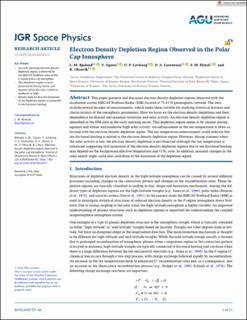| dc.contributor.author | Bjoland, Lindis Merete | |
| dc.contributor.author | Ogawa, Y. | |
| dc.contributor.author | Løvhaug, Unni Pia | |
| dc.contributor.author | Lorentzen, Dag Arne | |
| dc.contributor.author | Hatch, Spencer Mark | |
| dc.contributor.author | Oksavik, Kjellmar | |
| dc.date.accessioned | 2022-02-08T07:37:26Z | |
| dc.date.available | 2022-02-08T07:37:26Z | |
| dc.date.created | 2022-01-10T21:22:00Z | |
| dc.date.issued | 2021 | |
| dc.identifier.issn | 2169-9380 | |
| dc.identifier.uri | https://hdl.handle.net/11250/2977624 | |
| dc.description.abstract | This paper presents and discusses electron density depletion regions observed with the incoherent scatter EISCAT Svalbard Radar (ESR) located at 75.43°N geomagnetic latitude. The data include several decades of measurements, which make them suitable for studying statistical features and characteristics of the ionospheric parameters. Here we focus on the electron density depletions and their dependence on diurnal and seasonal variations and solar activity. An electron density depletion region is identified in the ESR data in the early morning sector. This depletion region seems to be clearest during equinox and winter and moderate/high solar activity. An enhancement in the ion temperature is often co-located with the electron density depletion region. The ion temperature enhancement could indicate that ion frictional heating is related to the electron density depletion region. However, during summer when the solar activity is low, the electron density depletion is not observed although the ion temperature is enhanced, suggesting that formation of the electron density depletion regions due to ion frictional heating may depend on the background effective temperature and O/N2 ratio. In addition, seasonal changes in the solar zenith angle could also contribute to the formation of the depletion region. | en_US |
| dc.language.iso | eng | en_US |
| dc.publisher | Wiley | en_US |
| dc.relation.uri | https://doi.org/10.1029/2020JA028432 | |
| dc.rights | Navngivelse 4.0 Internasjonal | * |
| dc.rights.uri | http://creativecommons.org/licenses/by/4.0/deed.no | * |
| dc.title | Electron Density Depletion Region Observed in the Polar Cap Ionosphere | en_US |
| dc.type | Journal article | en_US |
| dc.type | Peer reviewed | en_US |
| dc.description.version | publishedVersion | en_US |
| dc.rights.holder | Copyright 2020. The Authors | en_US |
| dc.source.articlenumber | e2020JA028432 | en_US |
| cristin.ispublished | true | |
| cristin.fulltext | original | |
| cristin.qualitycode | 2 | |
| dc.identifier.doi | 10.1029/2020JA028432 | |
| dc.identifier.cristin | 1977917 | |
| dc.source.journal | Journal of Geophysical Research (JGR): Space Physics | en_US |
| dc.relation.project | Norges forskningsråd: 223252 | en_US |
| dc.identifier.citation | Journal of Geophysical Research: Space Physics. 2021, 126 (1), e2020JA028432. | en_US |
| dc.source.volume | 126 | en_US |
| dc.source.issue | 1 | en_US |

